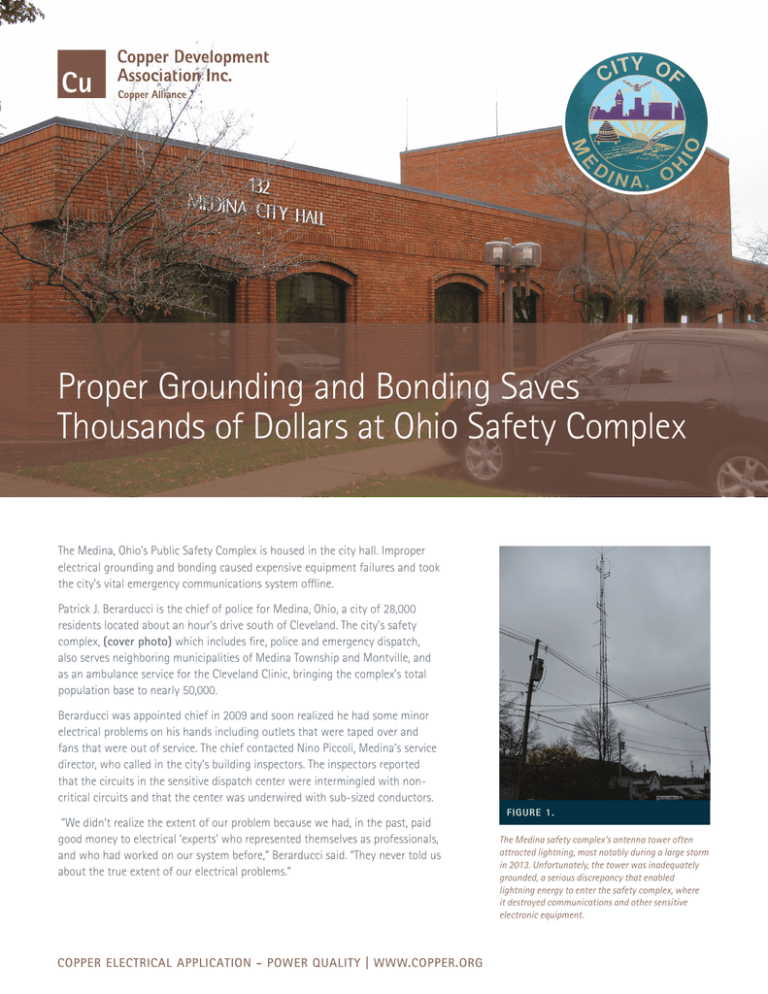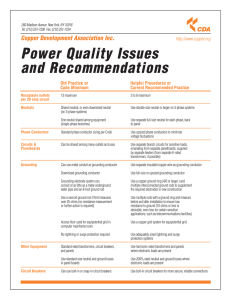Proper Grounding and Bonding Saves Thousands of Dollars at Ohio
advertisement

Proper Grounding and Bonding Saves Thousands of Dollars at Ohio Safety Complex The Medina, Ohio’s Public Safety Complex is housed in the city hall. Improper electrical grounding and bonding caused expensive equipment failures and took the city’s vital emergency communications system offline. Patrick J. Berarducci is the chief of police for Medina, Ohio, a city of 28,000 residents located about an hour’s drive south of Cleveland. The city’s safety complex, (cover photo) which includes fire, police and emergency dispatch, also serves neighboring municipalities of Medina Township and Montville, and as an ambulance service for the Cleveland Clinic, bringing the complex’s total population base to nearly 50,000. Berarducci was appointed chief in 2009 and soon realized he had some minor electrical problems on his hands including outlets that were taped over and fans that were out of service. The chief contacted Nino Piccoli, Medina’s service director, who called in the city’s building inspectors. The inspectors reported that the circuits in the sensitive dispatch center were intermingled with noncritical circuits and that the center was underwired with sub-sized conductors. “We didn’t realize the extent of our problem because we had, in the past, paid good money to electrical ‘experts’ who represented themselves as professionals, and who had worked on our system before,” Berarducci said. “They never told us about the true extent of our electrical problems.” COPPER ELECTRICAL APPLICATION - POWER QUALITY | WWW.COPPER.ORG FIGURE 1. The Medina safety complex’s antenna tower often attracted lightning, most notably during a large storm in 2013. Unfortunately, the tower was inadequately grounded, a serious discrepancy that enabled lightning energy to enter the safety complex, where it destroyed communications and other sensitive electronic equipment. Disaster Strikes “Our building inspectors also examined our circuits and after that we thought we were getting into pretty good shape,” Piccoli said. “Then disaster struck. We suffered a catastrophic loss one night in 2013 during a bad storm. Lightning struck our tower (Figure 1). We lost two-thirds of our dispatch center. Our emergency service workers had to communicate — if they could communicate at all — by using their laptops and portable radios. It didn’t take a rocket scientist to see that an electrical surge had entered our system. Ironically, the department had just completed an upgrade to its grounding system, but the company who installed it maintained that a surge wasn’t our problem.” The complex experienced over $20,000 worth of damages from the lightning strike. It took out Ethernet cards in one server, and then cascaded to other cards in four or five other computers and three radio consoles. “But the ongoing problem with electrical surges is that they weaken the system and things start to fail later on. It’s difficult to collect for damages then,” Baraducci said. “Beyond that was our loss of service. We had three dispatch stations and now, with that strike, we were down to one! “Our bigger loss was the Thank God we didn’t have a catastrophe computers in the detecwhile we were down.” tive bureau, including a server we relied on for historical information,” Zaremba said. Sergeant Darrin Zaremba, a Medina police officer who spent much of his 20-year career in charge of the city’s IT networks, said that he can recall the times before computers, when what was then considered a major event consisted of a cleaning crew taking down the dispatch center by plugging a vacuum cleaner into a sensitive circuit. Things are different now, he said, but that minor incident told him the center was already having problems. FIGURE 2. Equipment on adjacent IT server racks (at left) and radio racks (at right) suffered major damage from the 2013 lightning strike. It is believed that the racks shared a CAT-5 Ethernet cable to a time-synching computer. When lightning energy entered the building due to grossly inadequate (and incorrect) grounding and lightning protection, the shared CAT-5 cable provided a path for that energy to damage both the IT and communications systems. “Our bigger loss was the computers in the detective bureau, including a server we relied on for historical information,” Zaremba said. “Without that server, detectives weren’t able to do things as simple as send and receive an email or look up background information and other typical detective functions.” Zaremba explained how he believes the damage probably progressed. “Our IT and radio equipment components are mounted on separate racks (Figure 2). The grounding in our server rooms was, at the time, mostly on our radio racks, which were installed by one vendor. Unfortunately, my (IT-based) dispatch racks were tied to that radio rack since we shared an Ethernet cable to a time-synching computer on the radio rack. So, in effect, the radio racks were grounded to our computers on our IT rack, which, it turns out, was installed by a different vendor. FIGURE 3. A copper grounding busbar on the tower (center of photo) connects grounded shields on waveguides and coax cable shields serving various antennas (smaller-diameter cables). The large-diameter, vertical green grounding cable visible at the far lower left corner connects the busbar with the three driven electrodes and the buried copper ring ground surrounding the tower. COPPER ELECTRICAL APPLICATION - POWER QUALITY | WWW.COPPER.ORG “We shared that time-synching computer on the radio rack via a standard CAT-5 Ethernet cable. We suspect that the cable was draped across one of the antenna wires coming into the building from a copper grounding bar attached several yards up the tower (Figure 3). The surge probably jumped to the CAT-5 cable and then took out five Ethernet ports on the IT side, four of which were on detective computers. The radio rack and its equipment also took the hit, of course.” It is important to note that racking on the IT server side was appropriately grounded. The fatal deficiency was that grounding on the radio side was improperly installed by a different vendor. Finally, a Grounding Professional Piccoli called in Tim Cookson, a senior electrical engineer with 25 years of experience at PowerEdge Technologies, Inc., a consulting engineer and licensed electrical contractor in the state of Ohio who had performed a Power Quality Survey and grounding corrective work for the municipality in 2004. FIGURE 5. A copper grounding bar located in the server room near the communications cabinets. The bar collects grounding cables from the tower and the police department side of the safety complex. The AWG 4/0 green wire at lower right in the figure connects to the main grounding bar shown in Figure 6. FIGURE 4. The base of the antenna tower is shown here after the upgrade. The tower had originally been fitted with two grounding rods, but the rods had corroded unevenly, giving rise to a difference in their ground impedances. During the 2013 strike, lightning energy would have favored the lower-impedance rod, setting up a massive ground loop current in a circuit that included the interior grounding bar and the improperly grounded equipment racks shown in Figure 2. FIGURE 6. The complex’s main grounding (MGB) bar collects feeds from subsidiary bars located throughout the facility. The green cable at the top of the bar originates at the bar shown in Figure 5. The complex’ electrical service entrance at the left of the MGB and the water service entrance is at the right. COPPER ELECTRICAL APPLICATION - POWER QUALITY | WWW.COPPER.ORG FIGURE 7A. FIGURE 7B. New grounding connections at the tower base: 7a (left): exothermic welds bond grounding cables to one of the tower’s legs; 7b (right) exothermic welds also bond grounding cables with an extension of the buried copper ring ground. Through an audit, Cookson concluded that the tower and communications cables were never properly grounded,” said Piccoli. When the strike hit the tower, the surge was able to travel from the tower to the IT and communications racks and onward through the system. It blew out two radio computers in dispatch, damaged other electrical appliances, plus computers in our server rack and some other radios. Cookson first inspected the grounding system at the base of the center’s three-legged lattice tower, Figure 4, and found several serious issues. The tower had originally been provided with two electrically separate grounding rods, which was in itself a deficiency. To make matters worse, the rods were made from a material that corroded unevenly, a condition that led to the rods having different ground impedances. Thus, when lightning struck the tower, its energy would naturally have favored the lower-impedance rod of the two. In the process of seeking earth, the incoming energy would have set up a massive ground loop current that included both rods and an interior grounding bar (Figure 5) located behind the cabinets in the building’s communications room. Since — as Zaremba discovered earlier — the interior bar was also improperly connected directly to the equipment racks and to the main grounding bar (MGB), Figure 6, it was quite possible that lightning energy could flow from the tower to the interior bar and from there to the racks and downstream equipment. “We accepted Mr. Cookson’s recommendations and set him to work,” Berarducci said. “I’ll say from the beginning, that we have not had a lightning-induced incident since Tim installed our copper system and fixed our grounding. So my first words of advice to any police chief is get away from your equipment vendors and go with grounding professionals. If you have an electrical grounding issue, go to an electrical engineer, not a radio salesman.” COPPER ELECTRICAL APPLICATION - POWER QUALITY | WWW.COPPER.ORG The Fix Cookson first replaced the existing rods with three copper-clad 10-feet x ¾-inch rods, all of which were bonded to the legs of the tower and to a new bare copper 4/0 copper ring ground that was installed around the tower (Figure 7a and 7b). The existing rods (and therefore the tower) had been connected to the interior collector bar shown in Figure 5, and a lead from that bar was (mistakenly) directed to the racks shown in Figure 2. The most important result of Cookson’s corrections and subsequent improvements to the complex’s grounding system was that energy from any future lightning strike to the tower would be directed directly to earth via the low resistance/ impedance ring ground and electrodes at the tower base and not through paths that included sensitive “The advantage of using electronic equipment. The complex’s a grounding specialist or computers, servers and a professional engineer in critically important communications situations like this is the were thereby ability to look at the glob- equipment taken out of danger. al picture and not just rely on the knowledge of the equipment manufacturer,” Cookson said. “The advantage of using a grounding specialist or a professional engineer in situations like this is the ability to look at the global picture and not just rely on the knowledge of the equipment manufacturer,” Cookson said. “Vendors might have knowledge of their equipment but they don’t necessarily know how they will interact with the communications system they’re connecting with, not to mention the total electrical and grounding systems involved with the structure. Grounding specialists see that big picture and know how to deal with it.” The Principals Patrick J. Berarducci has been chief of the Medina police department since 2009. He became aware of electrical problems at the safety center early-on and initiated the process that eventually solved the many grounding issues. He can be reached through www.medinaoh.org. Nino Piccoli is the service director for the city of Medina. He had concerns that the city’s safety center had serious grounding problems, so he brought in Tim Cookson, who found and successfully upgraded the complex’s grounding and lightning protection systems. He can be reached through www.medinaoh.org. Sergeant Darrin Zaremba is a Medina police officer who has spent much of his 20-year career in charge of the city’s networks. He believes strongly that only professional engineers with specific experience in grounding and lightning protection should be entrusted with solving problems such as those found at the Medina center. Zaremba can be reached through www.medinaoh.org. Since the grounding system was upgraded, there have been no interruptions in communications and dispatch between the safety complex and the communities it serves. COPPER ELECTRICAL APPLICATION - POWER QUALITY | WWW.COPPER.ORG Tim Cookson is a senior electrical engineer with PowerEdge Technologies, an Ohio-based firm with more than two decades experience in grounding and lightning protection. He can be reached at 330-494-7314 or cooksont@poweredgetech.com. This publication has been prepared solely as resource material for the use of individuals involved in the specification, design, selection and installation of electrical systems. It has been compiled from information provided by one or more of the parties mentioned herein and other information sources Copper Development Association Inc. (CDA) and/or the relevant parties believe to be competent. However, recognizing that each system must be designed and installed to meet particular circumstances, CDA and the parties mentioned in this publication assume no responsibility or liability of any kind, including direct or indirect damages in connection with this publication or its use by any person or organization, AND MAKE NO REPRESENTATIONS OR WARRANTIES OF ANY KIND RELATED TO ITS USE, ACCURACY, COMPLETENESS, UTILITY, AVAILABILITY OR DOCUMENTATION. COPPER ELECTRICAL APPLICATION - POWER QUALITY | WWW.COPPER.ORG A6175 XX/16 copper.org



